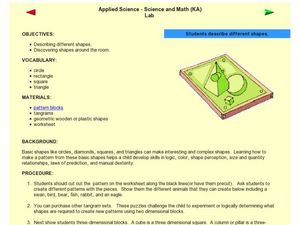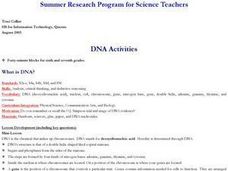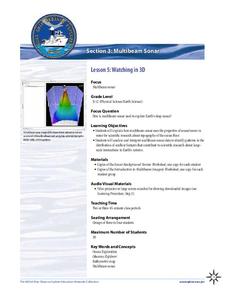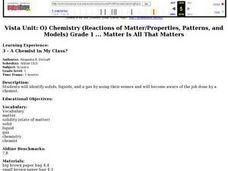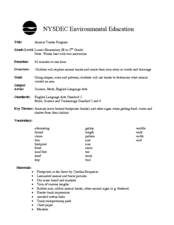Curated OER
Revise Identifying 3-D Shapes
In this 3-D shapes worksheet, students practice identifying 8 3-D shapes with their following precise names: cube, cuboid, square based pyramid, cone, cylinder, tetrahedron, octagonal prism and hexagonal prism.
Curated OER
Applied Science - Science and Math (K) Lab
In this shape instructional activity, learners cut out tangram shapes and create different pictures with them. They look at 3-D shapes as well. There is a nice, hands-on component built into this instructional activity.
Curated OER
Circles to Spheres
Students investigate circles and spheres. In this space shapes lesson, students compare and contrast two-dimensional and three-dimensional shapes. Students investigate the relationship between plane and space shapes.
Curated OER
Applied Science - Science and Math Lab
Create three dimensional objects in an applied science lesson plan. The goal is for your class to recognize, compare, and model shapes. Using cookie cutters and clay or play dough, they create models for three-dimensional shapes.
American Chemical Society
Finding Volume: The Water Displacement Method
We have formulas for finding the volume of geometric shapes, but what if the shape is irregular? Lesson describes how to find volume through water displacement. After a demonstration, scholars practice in small groups. Then analysis...
Curated OER
Planet/Constellation Mobile
Young scholars construct three-dimensional solar system mobiles.
Curated OER
Symmetry that is Basic and Beautiful
Learners explore lines of symmetry. In this symmetry lesson, students divide and combine shapes along basic lines of symmetry. Learners explore symmetry in real life objects.
Curated OER
Spies That Fly
High schoolers view a video clip about spy planes. They identify the challenges engineers face in building small aircraft. They complete a worksheet to end the lesson.
Curated OER
Creating your Frog's Environment
Students discuss where frogs can live. After the discussion, they create an environment for a frog using items of their choice. Some may include: construction paper, paint, magazines. The environment could even be 3-D. The key to this...
Curated OER
Polygons and Vertices
In this geometry worksheet, students analyze different polygons and relate it to a circuit board. They find the odd degree Euler circuit and identify the vertices of the odd degree. There are 3 questions with an answer key.
Curated OER
Watershed Works: Unit 1
By constructing a watershed model and identifying watershed features in it, they discover how water erosion changes the landscape. As with most watershed modeling activities, this one is costly in terms of time and materials. It is,...
Curated OER
DNA Activities
Learners work together to identify the structure of DNA. They practice using new vocabulary as well. They create a 3-D model of DNA to complete the lesson plan.
Curated OER
Science: The Shape of Clouds
Students observe cloud formations during a trip outdoors prior to reading Tomie dePaola's , "The Cloud Book." Using cotton, they make models of the four main cloud shapes and mount them on blue construction paper. As an ongoing project,...
Curated OER
Chemistry Day With Glitter Wands
First graders observe examples of the three states of matter and identify matter in each of the three states. They make glitter wands to remind them of the three states of matter: solid, liquid and gas. Pupils brainstorm and record...
Curated OER
WS 8.1 Solutions
In this solutions worksheet, students identify solutes and solvents from a list of solutions and they draw water molecules bonding to each other. They fill in the blanks with terms related to bonding in solutions, density of solutions...
Curated OER
Organic Chemistry 231, Martin Larter, Exam 1
If you need a straightforward and comprehensive organic chemistry exam, check this one out. Chemistry pupils identify functional groups in molecule diagrams, draw a Lewis structure, fill in a table about molecular shape, predict boiling...
NASA
States of Matter
Water, one of the basic needs of humans, is found in all three states of matter on Earth; no other planet—that we know of—possesses this quality. Here is a unit that allows learners to explore through experimentation what it...
NOAA
Watching in 3D
Bring the ocean floor to life! Earth science scholars discover the process of deep sea mapping in the third installment in a series of five lessons about ocean exploration. The teacher's guide includes helpful resources, worksheets, and...
Curated OER
What is the Rock Cycle and Its Processes?
Geology beginners examine three different rock samples and determine their origin by their characteristics. By making and recording observations, they become familiar with features of igneous, metamorphic, and sedimentary rock types....
Curated OER
Rap-Tap-Tap
Fifth graders investigate incline planes and wedges. They identify a variety of incline planes and wedges that are found all around them. Students record their findings using a worksheet.
Curated OER
A Chemist in My Class?
First graders in kindergarten science class discuss matter. They make predictions and then identify mystery items in brown paper bags as either solid, liquid, or gas by using their senses. They discuss that a chemist is a scientist that...
Curated OER
Name that metal!
Learners have to have had some experience with metals prior to using this worksheet. They are given five properties common to five different metals. They create or use a dichotomous key to identify the five mystery metals. Tip: This...
Curated OER
Understanding Topographic Maps
Underclassmen create a cone-shaped landform and then draw a contour map for it. Then they examine a quadrangle (which was easily located with an online search), and relate it to what they experienced. The accompanying worksheet is...
Curated OER
Animal Tracks Program
Entice your learners with this lesson on animal footprints. After reading the story Footprints in the Snow by Cynthia Benjamin, they use photos to identify animals and their footprints. Then they participate in an activity to classify...

